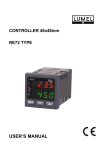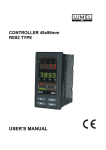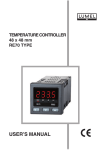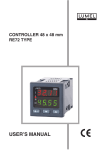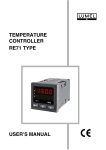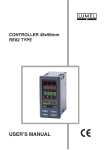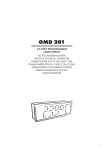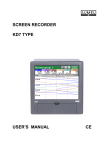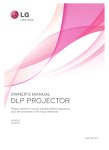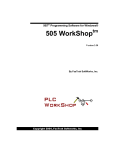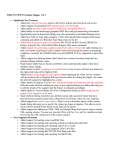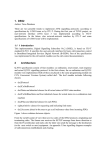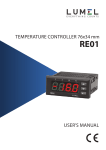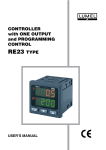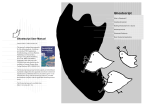Download USER`S MANUAL
Transcript
CONTROLLER 48x48mm RE72 TYPE USER’S MANUAL RE72-09 User’s Manual 2 CONTENTS: 1. 2. 3. 4. 4.1. 4.2. 4.3. 5. 6. 6.1. 6.2. 6.3. 6.4. 7. 7.1. 7.2. 7.3. 7.4. 8. 8.1. 8.2. 8.3. 8.4. 8.5. 9. 10. 11. 12. 12.1. 12.2. 12.3. 12.4. 12.5. 12.6. 13. 13.1. 13.2. 13.3. 14. 14.1. 14.2. 14.3. 15. 16. 17. 18. APPLICATION ............................................................................................................... 3 CONTROLLER SET ...................................................................................................... 3 BASIC REQUIREMENTS, OPERATIONAL SAFETY .................................................... 4 INSTALLATION ............................................................................................................. 4 Controller Installation ..................................................................................................... 4 Electrical Connections ................................................................................................... 5 Installation Recommendations....................................................................................... 7 STARTING TO WORK .................................................................................................. 7 SERVICE ....................................................................................................................... 9 Programming Controller Parameters ........................................................................... 10 Programming Matrix .................................................................................................... 11 Setting Change ............................................................................................................ 12 Parameter Description ................................................................................................. 12 CONTROLLER INPUTS AND OUTPUTS ................................................................... 19 Main Measuring Inputs ................................................................................................ 19 Additional Measuring Inputs ........................................................................................ 20 Binary Inputs................................................................................................................ 20 Outputs ........................................................................................................................ 20 CONTROL ................................................................................................................... 21 ON-OFF Control .......................................................................................................... 21 Innovative SMART PID Algorithm ................................................................................ 21 Stepper control ............................................................................................................ 24 “Gain Scheduling” Function ......................................................................................... 24 Control of Heating-cooling Type .................................................................................. 25 ALARMS ...................................................................................................................... 26 TIMER FUNCTION ...................................................................................................... 26 CURRENT TRANSFORMER INPUT ........................................................................... 27 ADDITIONAL FUNCTIONS ......................................................................................... 28 Control Signal Monitoring ......................................................................................... 28 Manual Control ......................................................................................................... 28 Signal Retransmission .............................................................................................. 28 Set Point Change Rate – Soft Start .......................................................................... 29 Digital Filter............................................................................................................... 29 Manufacturer’s Settings ............................................................................................ 30 PROGRAMMING CONTROL ...................................................................................... 30 Description of Programming Control Parameters ..................................................... 30 Definition of Set Point Value Programs. ................................................................... 32 Control of the Set Point Value Program .................................................................... 34 RS-485 INTERFACE WITH MODBUS PROTOCOL ................................................... 36 Introduction ............................................................................................................... 36 Error Codes .............................................................................................................. 36 Register Map ............................................................................................................ 36 ERROR SIGNALING ................................................................................................... 46 TECHNICAL DATA ...................................................................................................... 47 CONTROLLER VERSION CODES ............................................................................. 49 MAINTENANCE AND GUARANTEE ........................................................................... 50 RE72-09 User’s Manual 3 1. APPLICATION The RE72 controller is destined for the temperature control in plastics, food, dehydration industries and everywhere when the temperature change stabilization is necessary. The measuring input is universal for resistance thermometers (RTD), thermocouple sensors (TC), or for linear standard signals. The controller has three outputs enabling the two-step control, step-by-step three-step control, threestep control of heating-cooling type and alarm signaling. The two-step control is acc. to the PID or ON-OFF algorithm. The innovative SMART PID algorithm has been implemented in the controller. 2. CONTROLLER SET 1 2 3 4 RE72 5 The delivered controller set is composed of: ▪ RE72 controller ▪ Plug with 6 screw terminals ▪ Plug with 8 screw terminals ▪ Screw clamp to fix the controller in the panel ▪ Seal ▪ User’s manual ▪ Guarantee card 1 pc 1 pc 1 pc 4 pcs 1 pc 1 pc 1 pc When unpacking the controller, please check whether the type and version code on the data plate correspond to the order. RE72-09 User’s Manual 4 3. BASIC REQUIREMENTS, OPERATIONAL SAFETY In the safety service scope, the controller meets to requirements of the EN 61010-1 standard. Observations Concerning the Operational Safety ▪ All operations concerning transport, installation, and commissioning as well as maintenance, must be carried out by qualified, skilled personnel, and national regulations for the prevention of accidents must be observed. ▪ Before switching the controller on, one must check the correctness of connections to the network. ▪ Do not connect the controller to the network through an autotransformer. ▪ The removal of the controller casing during the guarantee contract period may cause its cancellation. ▪ The controller fulfills requirements related to electromagnetic compatibility in the industrial environment ▪ When connecting the supply, one must remember that a switch or a circuit-breaker should be installed in the room. This switch should be located near the device, easy accessible by the operator, and suitably marked as an element switching the controller off. ▪ Non-authorized removal of the casing, inappropriate use, incorrect installation or operation, create the risk of injury to personnel or meter damage. For more detailed information, please study the User’s Manual. 4. INSTALLATION 4.1. Controller Installation Fix the controller in the panel, which the thickness should not exceed 15 mm, by means of four screw clamps acc. to the fig. 1. The panel cut-out should have 45+0.6 x 45+0.6 mm 1 Fig.1 Controller fixing in the panel Controller overall dimensions are presented on the fig. 2. 2 RE72-09 User’s Manual 5 max. 93 8 70 48 48 max.15 Fig. 2. Controller dimensions. 4.2. Electrical Connections The controller has two separable terminal strips with screw terminals. One strip enables to connect the supply and outputs by a wire of 2.5 mm2 cross-section. The second strip enables to connect input signals by a wire of 1.5 mm2 cross-section. RS-485 interface output 1 output 3/binary input/ supply of transducers 24 V output 2 Input signals supply Fig. 3. View of controller connecting strips 13 14 supply zasilanie Fig. 4. Supply RE72-09 User’s Manual 3 2 1 RTD Pt100 in two-wire system Pt1000 zwora jumper RTD Pt100 in 3-wire system - 3 2 0/4...20 mA + jumper zwora + - Thermocouple 3 2 1 RTD Pt1000 4 3 2 0...5/10 V + zwora jumper 3 2 1 Pt100 - Pt100 6 Current input 0/4..20mA 3 2 1 Voltage input 0..5/10V Fig. 5. Input signals - 6 5 0/4...20 mA + Fig. 6. Additional input signal Output 1, 2 – relay Output 1, 2 – voltage 0/5 V Output 1, 2 – continuous current 0/4...20 mA Output 1, 2 – continuous voltage 0...5/10 V Output 3 – relay Fig. 7. Control outputs/ alarming 6 5 Fig. 8. Binary input RE72-09 User’s Manual 7 Fig. 9. Current transformer input B (-) RS-485 A (+) 8 7 Fig. 10. RS-485 Interface + 6 5 Fig. 11. Supply of 24V transducers 4.3. Installation Recommendations In order to obtain a full fastness against electromagnetic noise, it is recommended to observe following principles: - do not supply the controller from the network in the proximity of devices generating high pulse noise and do not apply common earth circuits, - apply network filters, - wires leading measuring signals should be twisted in pairs, and for resistance sensors in 3-wire connection, twisted of wires of the same length, cross-section and resistance, and led in a shield as above, - all shields should be one-side earthed or connected to the protection wire, the nearest possible to the controller, - apply the general principle, that wires leading different signals should be led at the maximal distance between them ( no less than 30 cm), and the crossing of these groups of wires made at right angle (90º). 5. STARTING TO WORK After turning the supply on, the controller carries out the display test, displays the r e7 2 inscription, the program version and next, displays measured and set point values. A character message informing about abnormalities may appear on the display (table 18). The PID control algorithm with the proportional range 30ºC, integration time constant of 300 seconds, differentiation time constant of 60 seconds and pulse period of 20 seconds is set by the manufacturer. Changing the Set Point Value One can change the set point value by pressing the ? or the > push-button (fig. 12). The beginning of change is signaled by the flickering dot of the lower display. One must accept the new set point value by pressing the @ push-button during 30 seconds since the last pressure of the ? or > push-button. In the contrary, the old value will be restored. The change limitation is set by parameters spl and s pH. RE72-09 User’s Manual 8 Measured value Set point value Signaling the change Change acceptation To change the set point value Press one of the push-button Fig. 12. Fast change of set point value RE72-09 User’s Manual 6. SERVICE The controller service is presented on the fig. 13 Fig. 13. Menu of controller service 9 RE72-09 6.1. User’s Manual 10 Programming Controller Parameters The pressure and holding down the @ push-button during ca 2 sec. causes the entry in the programming matrix. The programming matrix can be protected by an access code. In case when giving a wrong value of the code, it is only possible to see settings through – without the possibility of changes. The fig 14. presents the transition matrix in the programming mode. The transition between levels is carrying out by means of ? and > push-buttons and the level selection by means of the @ push-button. After selecting the level, the transition between parameters is carried out by means of ? and > push-buttons. In order to change the parameter setting, one must proceed acc. to the section 6.3. In order to exit from the selected level, one must transit between parameters until the symbol [. . .] appears and press the @ push-button. In order to exit from the programming matrix to the normal working mode, one must transit between levels until the symbol [. . .] appears and press the @ push-button. Some controller parameters can be invisible – it depends on the current configuration. The table 1 includes the description of parameters. The return to the normal working mode follows automatically after 30 seconds since the last push-button pressure. RE72-09 6.2. User’s Manual Programming Matrix Fig. 14. Programming matrix 11 RE72-09 User’s Manual 6.3. 12 Setting Change The change of the parameter setting begins after pressing the @ push-button during the display of the parameter name. The setting selection is carried out through ? and > push-buttons, and accepted by the @ push-button. The change cancellation follows after the simultaneous pressing of ? and > push-buttons or automatically after 30 sec since the last push-button pressure. The way to change the setting is shown on the fig. 15. + Beginning of rozpoczęcie zmian changes Cancellation anulowanie ofzmian changes + Beginning rozpoczęcieof zmian changes akceptacja Acceptation zmian akceptacja Acceptation zmian of changes of changes zmniejszenie zwiększenie Value Value wartości wartości decreasing increasing Cancellation anulowanie ofzmian changes poprzedni następny Next Previous parametr parametr parameter parameter Fig. 15. Change of number and text parameter settings 6.4. Parameter Description The list of parameters in the menu is presented in the table 1. List of configuration parameters Parameter symbol Parameter description Table 1 Manufacturer setting Range of parameter changes sensors Linear input i n p – Input parameters unit Unit iNty Kind of main input dp Position of the main input decimal point qC pt1 1-dp qC: Celsius degrees qf: Fahrenheit degrees pU: physical units pt1: Pt100 pt10: Pt1000 t-,: thermocouple of J type t-t thermocouple of T type t-k: thermocouple of K type t-s: thermocouple of S type t-r: thermocouple of R type t-b: thermocouple of B type t-e: thermocouple of E type t-n: thermocouple of N type t-l: thermocouple of N type 0-20: linear current 0-20mA 4-20: linear current 4-20mA 0-5: linear voltage 0-5 V 0-10: linear voltage 0-10 V 0_dp: without decimal 0_dp: without point 1_dp: 1 decimal point decimal 1_dp: 1 decimal place 2_dp: 2 place decimal place RE72-09 Parameter symbol iNlo iNHi User’s Manual Parameter description Indication for the lower threshold of the linear main input Indication for the upper threshold of the linear main input 13 Manufacturer setting sensors Linear input 0.0 - -1999…9999 1) 100.0 - -1999…9999 1) sHif measured value shift of the main input 0.0 °C i#ty Kind of the auxiliary input 4-20 dp2 Position of the decimal point 1-dp i#lo i#Hi Indication for the lower threshold of the auxiliary linear input Indication for the upper threshold of the auxiliary linear input filt Time constant of the filter bNin Binary input function Range of parameter changes -100.0…100.0 °C (-999…999 1) 180.0…180.0 °F) 0-20: linear current 0-20mA 4-20: linear current 4-20mA 0_dp: without decimal place 1_dp: 1 decimal place 2_dp: 2 decimal place 0.0 - -1999…9999 1) 100.0 - -1999…9999 1) !2 none off: filter disabled !2: time constant 0.2 s !5: time constant 0.5 s 1: time constant 1 s 2: time constant 2 s 5: time constant 5 s 10: time constant 10 s 20: time constant 20 s 50: time constant 50 s 100: time constant 100 s none: none stop: control stop Hand: switching into manual working sp2: switching SP1 into SP2 rSat: erasing of timer alarm Psta: program start Pnst: jump to the next segment PHld: stopping to count the set point in the program o u t p – Output parameters out1 Function of output 1 y off: without function y: control signal Y0p: control signal for the stepper control – opening YCl: control signal for the stepper control - closing Cool : control signal - cooling RE72-09 Parameter symbol User’s Manual Parameter description o"ty Output type 1 out2 Function of output 2 o#ty output type 2 out3 Function of output 3 14 Manufacturer setting 4-20 2) off 4-20 off 2) Range of parameter changes sensors Linear input AHi: upper absolute alarm Alo: lower absolute alarm dwHi: upper relative alarm dwlo: lower relative alarm dwin: inner relative alarm dwou: outer relative alarm aLtr: timer alarm retr: retransmission eu1: auxiliary output for the program-following control eu2: auxiliary output for the program-following control rely: relay output ssr: voltage output 0/5 V 4-20: continuous current output 4 – 20 mA 0-20: continuous current output 0 – 20 mA 0-5: continuous voltage output 0–5V 0-10: continuous voltage output 0 – 10 V off: without function y : control signal Y0p: control signal of stepper control – opening YCl: control signal of stepper control – closing Cool : control signal - cooling AHi : absolute upper alarm Alo: absolute lower alarm dwHi: relative upper alarm dwlo relative : lower alarm dwin: inner relative alarm dwou: outer relative alarm aLtr: timer alarm aLhb heater damage alarm aLos: controlling element damage alarm (short circuit) retr: retransmission eu1: auxiliary output for the program-following control eu2: auxiliary output for the program-following control rely: relay output ssr: voltage output 0/5 V 4-20: current continuous output 4 – 20 mA 0-20: current continuous output 0 – 20 mA 0-5: voltage continuous output 0–5V 0-10: voltage continuous output 0 – 10 V off: without function y: control signal RE72-09 Parameter symbol User’s Manual Parameter description 15 Manufacturer setting Range of parameter changes sensors Linear input Y0p: control signal of stepper control – opening YCl: control signal of stepper control – closing Cool : control signal - cooling AHi: absolute upper alarm Alo: absolute lower alarm dwHi: relative upper alarm dwlo: relative lower alarm dwin: inner relative alarm dwou: outer relative alarm aLtr: timer alarm aLhb heater damage alarm aLos: controlling element damage alarm (shortcircuit) eu1: auxiliary output for the program-following control eu2: auxiliary output for the program-following control Yfl to1 to2 to3 Control signal of control output for proportional control in case of the sensor damage. 0.0 0.0…100.0 Pulse period of output 1 20.0 s 0.5…99.9 s Pulse period of output 2 20.0 s 0.5…99.9 s Pulse period of output 3 20.0 s 0.5…99.9 s c t r l – Control parameters alg Control algorithm pid type Kind of control inu Hy Hysteresis 1.1 °C Hn Displacement zone for heating-cooling control or dead zone for stepper control. 10.0 °C Gty Gsnb Gl12 Gl23 Gl34 “Gain Scheduling “ function Number of PID sets for “Gain Scheduling” from the set point value Switching level for PID1 and PID2 sets Switching level for PID2 and PID3 sets Switching level for PID3 and PID4 sets off 2 oNof: control algorithm on-off pid: control algorithm PID dir: direct control (cooling) inu: reverse control (heating) 0.2…100.0 °C (0.2…180.0 °F) 0.0…100.0 °C (0.0…180.0 °F) 0…999 1) off: disabled sp: from set point value set:constant PID set 2: 2 PID sets 3: 3 PID sets 4: 4 PID sets 0.0 MIN…MAX 3) 0.0 MIN…MAX 3) 0.0 MIN…MAX 3) RE72-09 User’s Manual Parameter symbol Parameter description Gset Selection of the constant PID set sTlo sTHi fdb Lower threshold for autotuning Upper threshold for autotuning Stepper control algorithm type 16 Manufacturer setting pid1 Range of parameter changes sensors Linear input pid1: PID1 set pid2: PID2 set pid3: PID3 set pid4: PID4 set 0.0 ºC MIN…MAX 3) 800.0 ºC MIN…MAX 3) no no: algorithm without feedback yes: algorithm with feedback p i d – PID parameters pb ti pid1 td 30.0 °C 0.1…550.0 °C (0.1…990.0 °F) Integration time constant 300 s 0…9999 s Differentiation time constant 60.0 s 0.0…2500 s Proportional band 0…100.0 % y0 Correction of the control signal, for P or PD control type pid2 pb2 ti2 td2 y 02 Second set of PID parameters as PB, TI, TD, Y0 pid3 pb3 ti3 td3 y 03 Third set of PID parameters as PB, TI, TD, Y0 Fourth set of PID parameters as PB, TI, TD, Y0 pid4 pb4 ti4 td4 y04 pbC pidC tiC tdC 0.0 % Proportional band for the cooling channel (in relation to PB) 100 % 0.1...200 % Integration time constant 300 s 0…9999 s Differentiation time constant 60.0 s 0.0…2500 s RE72-09 User’s Manual 17 a l a r – Alarm parameters a"sp a"du a"Hy a"lt a#sp a#du a#Hy a#lt a$sp a$du a$Hy a$lt hBsp hBHy oSsp oSHy Set point value for absolute alarm1 Deviation from the set point value for relative alarm 1 100.0 0.0 °C Hysteresis for alarm 1 2.0 °C Memory of alarm 1 off Set point value for absolute alarm 2 Deviation from the set point value for relative alarm 2 100.0 0.0 °C Hysteresis for alarm 2 2.0 °C Memory of alarm 2 off Set point value for absolute alarm 3 Deviation from the set point value for relative alarm 3 100.0 °C 0.0 °C Hysteresis for alarm 3 2.0 °C Memory of alarm 3 off Set point for the heater damage alarm Hysteresis for the heater damage alarm Set point for the controlling element damage alarm (short-circuit) Hysteresis for the controlling element damage alarm (short-circuit) MIN…MAX 3) -200.0… 200.0 °C (-360.0… 360.0 °F) 0.2…100.0 °C (0.2…180.0 °F) Off:disabled on: enabled MIN…MAX 3) -200.0… 200.0 °C (-360.0… 360.0 °F) 0.2…100.0 °C (0.2…180.0 °F) off: disabled on: enabled MIN…MAX 3) -200,0… 200,0 °C (-360.0… 360.0 °F) 0.2…100.0 °C (0.2…180.0 °F) off: disabled on: enabled 0.0 A 0.0…50.0 A 0.1 A 0.0…50.0 A 0.0 A 0.0…50.0 A 0.1 A 0.1…50.0 A sp"2 sp"2: set point value SP1 or SP2 Rmin: set point value with soft start in units per minute RHr: set point value with soft start in units per hour in2: set point value from the additional input prg: set point value from programming control 1 1…15 Set point value SP1 0.0 °C MIN…MAX 3) Set point value SP2 0.0 °C MIN…MAX 3) Set point value SP3 0.0 °C MIN…MAX 3) Set point value SP4 0.0 °C MIN…MAX 3) -200 °C MIN…MAX 3) s p p – Set point value parameters sPmd Kind of set point value /prg sp1 sp2 sp3 sp4 spl Program No to carry out Lower limitation of the fast set point value change RE72-09 Parameter symbol spH sPrr User’s Manual Parameter description Upper limitation of the fast set point value change Accretion rate of the set point value SP1 or SP2 during the soft start . 18 Manufacturer setting 1767.0 °C 0.0 °C Range of parameter changes sensors Linear input MIN…MAX 3) 0…999.9 / time unit 4) 0…9999 1) / time unit 4) p r g – Programming control parameters The description of parameters is in the section: Programming control – table 5 i n t e – Serial interface parameters addr Device address baud Transmission rate prot Protocol 1 *6 r8n2 1…247 %8: 4800 bit/s *6: 9600 bit/s 1*2: 19200 bit/s 3)4: 38400 bit/s 5(6: 57600 bit/s none: lack r8n2: RTU 8N2 r8e1: RTU 8E1 r8o1: RTU 8O1 r8n1: RTU 8N1 r e t r – Retransmission parameters aOfn Quantity retransmitted on the continuous output aOlo aOHi Lower threshold of the signal to retransmit Upper threshold of the signal to retransmit pu pu: measured value on the main input PV pu2: measured value on the additional input PV2 p1-2: measured value PV – PV2 p2-1: measured value PV2 – PV sp: set point value du: control deviation (set point value – measured value) 0.0 MIN…MAX 3) 100.0 MIN…MAX 3) 0 0…9999 s e r p – Service parameters seCU sTfn timr time Di2 DCt Access code to the menu Auto-tuning function timer function Counting off the time by the timer Monitoring of the auxiliary input Monitoring of the heater current on off 30.0 min off off off: locked on: available off: disabled on: enabled 0.1…999.9 min off: disabled on: enabled off: disabled on: enabled RE72-09 User’s Manual Parameter symbol tout 1) 2) 3) 4) Parameter description 19 Manufacturer Time of the automatic output from the monitoring mode setting Range of parameter changes sensors 30 s Linear input 0…9999 s The definition at which the given parameter is shown depends on the parameter dp – position of the decimal point. For the output 0/4…20 mA, parameter to write, for other cases, to readout – acc. to the version code. See table 2. Time unit defined by the parameter spmd (Rmin, RHr). Caution! The accessibility of parameters depends on the controller version and its current settings. Parameters depended on the measuring range Symbol Input/ sensor Table 2 MIN MAX -200 °C 850 °C (-328 °F) (1562 °F) -200 °C 850 °C pt10 Resistance thermometer Pt1000 (-328 °F) (1562 °F) -100 °C 1200 °C t-, Thermocouple of J type (-148 °F) (2192 °F) -100 °C 400 °C t-t Thermocouple of T type (-148 °F) (752 °F) -100 °C 1372 °C t-k Thermocouple of K type (-148 °F) (2501,6 °F) 0 °C 1767 °C t-s Thermocouple of S type (32 °F) (3212,6 °F) 0 °C 1767 °C t-r Thermocouple of R type (32 °F) (3212,6 °F) 0 °C 1767 °C t-b Thermocouplke of B type (32 °F) (3212,6 °F) -100 °C 1000 °C t-e Thermocouple of E type (-148 °F) (1832 °F) -100 °C 1300 °C t-n Thermocouple of N type (-148 °F) (2372 °F) -100 °C 800 °C t-l Thermocouple of L type (-148 °F) (1472 °F) 0-20 9999 1) Linear current 0-20mA -1999 1) 1) 4-20 9999 1) Linear current 4-20 mA -1999 1) 0-5 9999 1) Linear voltage 0-5 V -1999 0-10 9999 1) Linear voltage 0-10 V -1999 1) 1) . The definition at which the given parameter is shown depends on the parameter dp – position of the decimal point. pt1 Resistance thermometer Pt100 7. CONTROLLER INPUTS AND OUTPUTS 7.1. Main Measuring Inputs The main input is the source of measured value taking part in control and alarms. The main input is an universal input, to which one can connect different types of sensors or standard signals. The selection of the input signal type is made by the parameter iNty . The position of the decimal point which defines the display format of the measured and the set point value is set by the parameter dp. For linear inputs, one must set the indication for the lower and upper analog input threshold iNlo and iNHi . The correction of the measured value indication is carried out by the parameter shif. RE72-09 7.2. User’s Manual 20 Additional Measuring Inputs The additional input can be the source of remote set point value(sPmd set on i n 2 ) or the signal for retransmission (aOfn set on pv2 ). The additional input is a linear input. The selection of the input signal type is possible between 0…20 mA and 4…20 mA by the parameter i#ty . The position of decimal point which defines the display format of the measured and set point value is set by the parameter dp2 . One must also set the indication for the lower and upper analog input threshold i#lo and i#Hi. The signal from the additional input is displayed with the character „d ” on the first position. To display the value, one must press the @ push-button till the moment of its appearance on the lower display (acc. to the fig. 13.) The return to display the set point value is set by the manufacturer for 30 sec, but it can be changed, or disabled through the parameter to u t . 7.3. Binary Inputs The function of the binary input is set by the parameter bNin . Following binary input functions are available: - without function – the binary input state does not influence the controller operation, - control stop – the control is interrupted , and control outputs are behaved as after a sensor damage, alarm and retransmission operate independently, - switching on manual operation – transition to the manual control mode’ - switching SP1 on SP2 – change of the set point value during the control, - erasing of the timer alarm – disabling of the relay responsible for the timer alarm, - program start – the programming control process begins (after a prior set of the programming control), - jump to the next segment – the transition to the next segment, follows during the duration of programming control. - stoppage to count the set point value in the program – the stoppage of set point value counting follows during the duration of the programming control. 7.4. Outputs The controller has maximal three outputs. Each of them can be configured as a control or an alarm output. For the proportional control (with the exception of analog outputs), the pulse period is additionally set. The pulse period is the time which goes by between successive switches of the output during the proportional control. The length of the pulse period must be chosen depending on dynamic object properties and suitably for the output device. For fast processes, it is recommended to use SSR relays. The relay output is used to steer contactors in slow-changing processes. The application of a high pulse period to steer slow-changing processes can give unwanted effects in the shape of oscillations. In theory, lower the pulse period, better the control, but for a relay output it can be as large as possible in order to prolong the relay life. Recommendations concerning the pulse period: output Pulse period to Electromagnetic relay Recommended >20 s, min.10 s Min. 5 s Transistor output 1…3 sec Table 3 Load 2 A/230 V a.c. 1 A/230 V a.c. SSR relay RE72-09 User’s Manual 21 8. CONTROL 8.1. ON-OFF Control When a high accuracy of temperature control is not required, especially for objects with a great time constant and small delay, one can apply the on-off control with hysteresis. Advantages of this way of control are simplicity and liability, but disadvantage are the occurring oscillations, even at small hysteresis values. wyjście Output Hy Enabled załączone wyłączone Disabled sp wartość Measured mierzona value Fig. 16. Operation way of the heating output type 8.2. Innovative SMART PID Algorithm When a high accuracy of the temperature control is required, one must use the PID algorithm. The applied innovative SMART PID algorithm is characterized by an increased accuracy for a widen class range of controlled objects. The controller tuning of the object consists on the manual setting of the proportional element value, integration element, differentiation element, or automatically – by means of the auto-tuning function. 8.2.1. Auto-tuning The controller has the function to select PID settings. These settings ensure in most of case an optimal control. To begin the auto-tuning, one must transit to the t u n e message (acc. to the fig. 13) and push-button during at least 2 seconds. If the control algorithm is set on hold down the @ on-off or the auto-tuning function is locked then, the tune message will be hidden. For a correct realization of the auto-tuning function, it is required to set S t l o and S t H i parameters. The sTlo parameter must be set on the value corresponding to the measured value at disabled control. For temperature control objects, one can set 0ºC One must set the s T H i parameter on the value corresponding to the maximum measured value at switched on control on full power. The flickering ST symbol informs about the activity of the auto-tuning function. The duration of auto-tuning depends on dynamic object properties and can last maximally 10 hours. In the middle of the auto-tuning or directly after it, over-regulations can occur, and for this reason one must set a smaller set point, if it possible. The auto-tuning is composed of following stages: RE72-09 User’s Manual 22 The auto-tuning process will be stopped without counting PID settings, if a supply decay occurs or the @ . push-button is pressed. In this case, the control with current PID settings begins. If the auto-tuning is not achieved with success, the error code will be displayed acc. to the table 4. Error codes for auto-tuning Error code Reason eS01 eS02 eS03 eS04 eS05 eS06 eS20 P or PD control was selected. The set point value is incorrect. The @ push-button was pressed. The maximal duration time of auto-tuning was exceeded. The waiting time for switching was exceeded Table 4 How to proceed One must select PI, PID control, i.e. the TI element must be higher than zero. One must change one or more set point value or sTlo , sTHi . Check if the temperature sensor is correctly placed and if the set point value is not set too higher for the given object. Pay attention for the sensor connection way. Do The measuring input range was exceeded. not allow that an over-regulation could cause the exceeding of the input measuring range Very non-linear object, making impossible Carry out the auto-tuning again. If that does not to obtain correct PID parameter values, or help, select manually PID parameters. noises have occurred. 8.2.2. Auto-tuning and “Gain Scheduling” In case, when “Gain Scheduling” is used, one can carry out the auto-tuning in two ways. The first way consist on choosing a suitable set of PID parameters, in which calculated PID parameters will be stored and realizing the auto-tuning on the level of the currently chosen set point value for the fixed set point control. One must set the Gty parameter on SE t , and choose G s e t between pid1 and pid4 The second way enables the automatic realization of the auto-tuning for all PID sets. One must set the Gty parameter on sp, and choose the number of PID sets for setting – RE72-09 User’s Manual 23 parameter G s nb. Set point values for individual PID sets must be give in sp, sp2, s p 3 , s p 4 parameters,. from the lowest to the highest. 8.2.3. Proceeding Way in Case of a Dissatisfying PID Control The best way to select PID parameters is to change the value into a twice higher or into a twice lower. During changes, one must respect following principles: a) Oscillations: - increase the proportional band, - increase the integration time, - decrease the differentiation time. b) Over-regulations: - increase the proportional band, - increase the integration time, - increase the differentiation time. c) Instability: - decrease the proportional band, - decrease the differentiation tim, a) Slow jump response: - decrease the proportional band, - decrease the integration time, Run of the controlled quantity Algorithms of contro ller operations P PD PI PID x t Pb Pb td Pb Pb td Pb Pb ti td Pb ti td x t Pb ti x Pb td t Pb td Pb ti x t Pb Pb ti Fig. 17 Way to correct PID parameters RE72-09 8.3. User’s Manual 24 Stepper control There are two stepper control algorithms available to steer the valve: − without feedback – valve opening and closing is run basing on the PID parameters and the control deviation − with feedback from the valve positioned – valve opening and closing run basing on the PID parameters, the control deviation and the valve position obtained using the additional input. To select the stepper control one of the outputs out1 …out3 should be set to Y 0 p and one of the outputs out1…out4 to YCl. For the algorithm without feedback – the f b d parameter should be set to no , for the algorithm with feedback - the fbd parameter should be set to yes . There should be set the dead zone around the set point value, where the valve does not change its position – the parameter Hn. The pulse period for both the outputs should be the same. The first loop - valve opening – operates as a reverse controller, the second loop – valve closing – operates as a direct controller. The PID parameters for the second loop are the same as for the first loop. The PD algorithm is recommended for the stepper control. The operation of a three-stage stepper controller with algorithm P is shown on the fig. 18. The auto-tuning algorithm is not available for the stepper control. The pulse period is the same for valve opening and valve closing (parameter to1). output 100% Channel I - opening Channel II - closing SP 0% pb Hn pb Input signal Fig. 18. three-stage stepper control 8.4. “Gain Scheduling” Function For control systems, Where the object behaves decidedly differently in various temperatures, it is recommended to use the “Gain Scheduling” function. The controller allows to remember up to four sets of PID parameters and switch them over automatically.. The switching between PID sets runs percussiveless and with hysteresis, in order to eliminate oscillations on switching limits. The G t y parameter settles the way of the function operation. o f f The function is disabled a) switching depending on the set point value. sp For the fixed set point control one must also choose the number of PID sets – the G snb parameter, and set switching levels in dependence from the number of PID sets. RE72-09 set User’s Manual 25 b) For the programmed control, one can set the PID set individually for each segment. Then, one must set the pid parameter on on for the given prnn program, in the P C f g group. Permanently setting of one PID set, the PID set is put through the G s e t parameter. PV SP P ID 4 P ID 1 . . . P I D 4 P ID 1 P ID 1 . . . P I D 4 P ID 2 Gl12 P ID 1 . . . P I D 4 P ID 3 Gl23 P ID 1 . . . P I D 4 P ID 1 . . . P I D 4 Gl34 czas P ID Fig 19. “Gain Scheduling” switched over from SP 8.5. Fig. 20. “Gain Scheduling” switched over for each segment in the programmed control time Control of Heating-cooling Type For the heating-cooling control, one of the outputs out1…out3 should be set to y, one of the outputs o u t1…out3 should be set to Cool and the displacement zone Hn for cooling should be configured. For the heating loop, the PID parameters should be configured: pb , ti , td , for the cooling loop the PID parameters: pbC , tiC , tdC . The parameter pbC is defined as the ratio of the p b parameter from the range 0.1…200.0 %. The pulse period for logic outputs (relay, SSR) is set independently for the heating and cooling loops (depending on the output, these are to1 … to3 ). If there is the need to use the PID control in one loop and the ON-OFF control in the other loop, one output should be set to PID control and the other one upper relative alarm. Control output wyjście sterujące 100% Main loop tor główny (heating) Hn (grzanie) Auxiliary loop tor pomocniczy (cooling) (chłodzenie) 0% Set point value wartość zadana [°C] Temperature temperatura [°C] Fig.21. Control with two loops – heating-cooling type RE72-09 User’s Manual 26 9. ALARMS Four alarms are available in the controller, which can be assigned: to each output. The alarm configuration requires the selection of the alarm kind through setting out 1, out 2, out 3 and out 4 parameters on the suitable type of alarm. Available types of alarms are given on the fig. 22. aLsp aLsp aLdu (>0) sp aLdu (<0) Absolute upper Absolute lower Relative upper [ A Hi ] [Alo] [dwHi] aLdu (>0) aLdu aLdu aLdu (<0) aLdu aLdu sp sp sp Relative lower Relative internal Relative external [d wlo] [dwin] [dwou] Rys. 22. Kinds of alarms The set point value for absolute alarms is the value defined by the a x.sp parameter, and for relative alarms, it is the deviation from the set point value in the main channel - a x.du parameter. The alarm hysteresis , i.e. the zone around the set point value, in which the output state is not changed, is defined by the a x.Hy parameter. One can set the alarm latch, i.e. the memorizing of the alarm state after stopping alarm conditions (parameter a x.lt = on ). The erasing of alarm memory can be made by the simultaneous pressure of ? and > push-buttons in the normal working mode or interface. 10. TIMER FUNCTION When reaching the set point temperature (SP) the timer begins the countdown of the time defined by the time parameter. After counting down to zero, the timer alarm is set, which remains active till the moment of the timer erasing. To activate the timer function, one must set the parameter timr= on . To indicate the alarm state on an output, one of the outputs out2…out4 should be set to aLtr. The timer status/ residual time is displayed with the mark „t” on the first position. To display it, one must press the @ push-button till the moment of it appearance on the lower display (acc. to the fig. 13) The return to the set point value display is set by the manufacturer on 30 sec, but can be changed, or disabled through the tout parameter. RE72-09 User’s Manual Status timer stopped Description - temperature over SP - Press the ? push-button Starting of the timer Press the ? Pause of the timer End of the countdown push-button Reaching zero by the timer During the countdown: Press ? and > push-buttons After the countdown end: - press the > push-button - through the binary input Timer erasing 27 Sygnaling t--Residual time in minutes: e.g. (t2*9 ) Flickering residual time in minutes tend PV SP Time countdown odliczanie czasu w dół czas[sec] [sek] Time kasowanie timera Timer erasing alarm timera Timer alarm Fig.23. Principle of timer operation 11. CURRENT TRANSFORMER INPUT After connecting the current transformer (designation CT-94-1), the measurement and display of the current flowing through the load steered by the output 1, is possible. The first output must be of relay or voltage 0/5 V type. For the current counting, the minimal time of the output switching on must be at least 200 ms. The transformer work range is equal from 0 to 50 A. The heater current is displayed with the mark “a ” in the first position. In order to display the heater current, one must press the @ push-button till the moment of it appearance on the lower display (acc. to the fig. 13). The return to the set point value display is set by the manufacturer on 30 sec, but can be changed or disabled through the tout parameter. Two types of alarms concerning the heating element are available. The alarm of damage the control element and alarm of the heater burnout. The alarm of the control element damage is realized by the current measurement when the control element is disabled, however the burnout alarm is realized when the control element is enabled. RE72-09 User’s Manual 28 The alarm configuration includes setting the alarm type. For the heater damage alarm o u t 2 or o u t 3 =a L hb , and for the controlling element damage alarm out2 or out3 =aLo s Remaining parameters to set are the alarm set point value h Bsp, oSsp and the h B H y , o S H y hysteresis. For a correct detection of the heater alarm burnout, the heating element can not be connected later than the controller. 12. ADDITIONAL FUNCTIONS 12.1. Control Signal Monitoring The control signal of heating type is displayed with the mark „h” on the first position, of cooling type is displayed with the mark “C”, of valve opening is displayed with the mark “o” and valve closing is displayed with the mark “c ” .The accessibility of the control signal depends on the suitable controller configuration. To display the control signal, one must press the @ pushbutton till the moment of its appearance on the lower display (acc. to the fig. 13). The return to the set point value display is set by the manufacturer on 30 sec. but it can be changed, or disabled through the tout parameter. 12.2. Manual Control The input to the manual control mode follows after holding down the @ push-button during the control signal display. The manual control is signaled by the pulsation of the LED diode. The controller interrupts the automatic control and begins the manual control of the output. The control signal value is on the lower display, preceded by the symbol “h” – for the main channel and “C” – for the auxiliary channel (cooling). The @ push-button serves to transit between channels (if the heating – cooling control mode has been selected). ? and > push-buttons serve to change the control signal. The exit to the normal working push-buttons. mode follows after the simultaneous pressure of ? and > At set on-off control on the output 1 (parameter PB=0), one can set the control signal on 0% or 100% of the power, however when the PB parameter is higher than zero, one can set the control signal on any value from the range 0…100%. 12.3. Signal Retransmission The continuous output can be used for the retransmission of selected value, e.g. in order to the temperature recording in the object or the set point value duplication in multi-zone furnaces. The signal retransmission will be possible if the output 2 is of continuous type. We begin the signal retransmission from setting the out2 parameter into retr. Additionally, one must set the upper and lower limit of the signal to be retransmitted (aOlo and aOHi ). The signal selection for retransmission is carried out through the aOfn parameter. The recounting method of the retransmitted parameter into a suitable analog signal is shown on the fig. 24. RE72-09 User’s Manual 29 wyjście output OUT wymax max OUT wyx x wymin OUT min aOl o x a OH i Fig. 24. Recounting of the signal for retransmission The output signal is calculated acc. to the following formula. wymax − wymin wy x = wymin + ( x − Ao.Lo) Ao.Lo − Ao.Hi The a O l o parameter can be set as higher than a O H i , but the output signal will be then, inversed. 12.4. Set Point Change Rate – Soft Start The limitation of the temperature accretion rate is carried out through the gradually change of the set point value. This function is activated after the controller supply connection and during the change of the set point value. This function allows to reach softly from the actual temperature to the set point value. One must write the accretion value in the s P r r parameter and the time unit in the ramp parameter. The accretion rate equals zero means that the soft start is disabled. 12.5. Digital Filter In case when the measured value is instable, one can switch a programmed low-pass filter on. One must set the lowest possible time constant at which the measured value is stable. A high time constant can cause the control instability. A high time constant can cause a control instability. The time constant of the filter f i l t can be set from 0.2 sec. up to 100 seconds. RE72-09 User’s Manual 30 Without a digital filter PV A With a digital filter 0,63A 0 t[s] Time constant filt Fig. 25. Time characteristic of the filter 12.6. Manufacturer’s Settings Manufacturer’s settings can be restored during the supply connection by holding down ? and > push-buttons, till the moment when the fabr inscription appears on the higher display. 13. PROGRAMMING CONTROL 13.1. Description of Programming Control Parameters List of configuration parameters Table 5 p r g – Programming control Sub-menu of the program no 1 … pr01 pr15 Sub-menu of the program no 15 PCfg Sub-menu of program parameters parameter Symbol Parameter description to begin the strt Way program Manufacturer’s setting pu Range of parameter change Sensors Linear input sp0: from the way defined by SP0 pu: from the currently measured value RE72-09 User’s Manual 31 sp0 Initial set point value 0,0 °C tMun Unit for the segment duration time mMss rRun Unit for the accretion rate of the set point value min MIN…MAX 1) mMss: minutes and seconds H~mm: hours and minutes min: minutes Hour: hours dis: inactive hold Locking of the control deviation dis lo: lower Hi: upper band: reversible Cy/n Number of program repetition fail Control after the supply decay 1 Cont 1…999 Cont: program continuation stop: control stoppage stop: Control stoppage end Control on the program end pid “Gain Scheduling functionfor the program stop off LSP: fixed set point control with set point from the last segment. off:disabled on: enabled … sT01 Submenu of program parameters Submenu of program parameters sT15 Submenu of program parameters Parameter symbol Parameter description Manufacturer’s setting Range of parameter change sensors linear input time: segment defined by the time type Kind of segment time rate:segment defined by the accretion duel: set point stoppage end: program end Tsp time rr Set point on the segment end 0.0 °C Segment duration 00.01 Accretion rate of the set point 0.1 MIN…MAX 1) 00.01…99.59 2) 0.1…550.0 °C / time unit 4) (0.1…990.0 °F / time unit 4)) 1…5500 °C 3)/ time unit 4) (1…9900 °F 3)/ time unit 4)) RE72-09 User’s Manual 32 Hldu Value of the control deviation for which the counting of set point is interrupted 0.0 eu1 State of the auxiliary output no 1 off eu2 pid State of the auxiliary Output no 2 PID set for the segment off Pid1 1) 0.0… 200.0 °C 0… 2000 °C 3) (0.0… 360.0 °F) (0… 3600 °F 3)) off: disabled on: enabled off: disabled on: enabled Pid1: PID1 Pid2: PID2 Pid3: PID3 Pid4: PID4 See table 2. The time unit is defined by the parameter tMun 3) The resolution to show the given parameter depends on the parameter dp – position of decimal point. 4) The time unit is defined by the parameter rRun. 2) 13.2. Definition of Set Point Value Programs. One can define 15 programs. The maximum number of segments in the program is equal to 15. To render visible parameters related to the programming control in the menu, the parameter s P md must be set on pr g . For each program, one must set parameters given in the submenu of program parameters. For each segment, one must select the kind of segment and next, parameters depending on the kind of segment, acc. to the table 6. One must also set the output state (only when o u t 1 … o u t3 are set on eu1 , eu2 ) – parameter eu1 and eu2 . List of segment configuration parameters t y p e = t ime type = rate Tsp Tsp time rr hldu hldu type = duel time Table 6 type = en d The fig. 26 and the table 7 represent an example of set point value program. It is assumed in the program that the temperature in the object has to increase from the initial temperature in the object up to 800ºC, with the rate of 20ºC per minute, at the active locking from the deviation. Next, during 120 minutes, the temperature is maintained (locking disabled), after that, the temperature has to decrease to 50ºC during 100 minutes (locking disabled). During the object cooling, one must turn on the fan connected to the auxiliary output no 2 (parameter out 2 set on e u 1 ). RE72-09 User’s Manual 33 PV 800°C 50°C czas time OUT2 ON OFF czas time Fig. 26. Example of program Parameter values for the example as above. PCfg sT01 sT02 sT03 sT04 Parameter strt tMun rRun hold Cy/n fail end type Tsp rr hldu eu1 type time eu1 type Tsp time hldu eu1 type eu1 value pu H~mm min band 1 cont stop rate 800,0 20,0 50,0 off duel 02.00 off time 50,0 01.40 0,0 on end off Table 7 Meaning Start to count the set point value from the current temperature Time unit: hour, minute Unit for the accretion rate: minute Locking for the program: active – two-sided Number of program repetitions Program continuation after a supply decay Control stoppage after the program end Kind of segment: accretion rate Target set point value: 800.0 °C Accretion rate 20.0 °C / minute Active locking, when the deviation exceeds 50.0 °C Output 2 as the auxiliary output Ev1: disabled Kind of segment: stoppage of set point value Segment time 2h00 = 120 minutes Output 2 as the auxiliary output Ev1 – disabled Kind of segment: accretion time Target set point value: 50.0 °C Segment time 1h40 = 100 minutes Inactive locking Output 2 as the auxiliary output Ev1: enabled Kind of segment: program end Output 2 as the auxiliary output Ev1: disabled RE72-09 13.3. User’s Manual 34 Control of the Set Point Value Program When the s P md parameter is set on prg , the controller controls the object in compliance with the set point value changing in time acc. to the given program. Before starting the control with the changeable set point value, one must select the required program (parameter / p r g ). To start the program, one must press ? and > push-buttons when the inscription s t o p appears on the lower display ( fig . 27). The lighted dot in the right corner of the lower display, means that the programming control is lasting. During the program duration, one can display parameters of the realized program, i.e. program status, program number, number of the operating segment, the number of cycles which still remains to carry out, time which goes by in the segment, time which remained to the end of the segment, time which remained to the program end. After finishing the program the dot is gone out, or the program is renewed, if the number of the program repetition Cy/n is higher than 1. After finishing the control, auxiliary outputs are in the state defined by parameters – output state for the segment set as the program end. When the parameter hold (locking in the program) is set on lo , Hi or band and the locking value h l d u in the operating segment is higher than zero then, the size of the control deviation is controlled (set point value minus measured value). For hold =lo the locking is active, when the measured value is below the set point value diminished by the locking value. For h o l d =Hi the locking is active, when the measured value exceeds the set point value by the locking value. For Hold=bAnd the locking is active, as for the upper and lower locking. If the locking is active then, the counting of the set point value is interrupted, and the dot in the right corner is flickering. The controller controls acc. to the last calculated set point value. RE72-09 User’s Manual Fig.27. Menu of programming control service 35 RE72-09 14. User’s Manual 36 RS-485 INTERFACE WITH MODBUS PROTOCOL 14.1. Introduction The RE72 controller is equipped with a serial interface in RS-485 standard, with implemented asynchronous communication protocol MODBUS. Combination of serial interface parameters for the RE72 controller: − device address: 1..247, − transmission rate: 4800, 9600, 19200, 38400, 57600 bit/s, − operating mode: RTU, − information unit: 8N2, 8E1, 8O1, 8N1, − data format: integer (16 bit), float (32 bit), float (2x16 bit), − maximum response time: 500 ms, − maximum number of registers read out/ written by a single Modbus frame: 116. The RE72 controller realizes following protocol functions: Table 8 code 03 06 16 17 14.2. Meaning read out of n-registers write of 1 register write of n-registers identification of the slave device Error Codes If the controller receives a request with a transmission or checksum error, the request will be ignored. For a request synthetically correct but with incorrect values, the controller will send an answer including the error code. Possible error codes and their meanings are presented in the table 9. Error codes Table 9 code meaning reason 01 forbidden function The function is not serviced by the controller 02 forbidden data address The register address is beyond the range 03 forbidden data value The register value is beyond the range or the register is only to readout. 14.3. Register Map Map of register groups Range of addresses Type of values 4000 – 4099 integer (16 bits) 4100 – 5599 integer (16 bits) 7000 – 7099 float (2x16 bits) 7500 – 7599 float (32 bits) Table 10 Description The value is situated in a 16-bit register The value is situated in a 16-bit register The value is situated in two successive 16-bit registers; Registers only for readout The value is situated in two successive 32-bit registers; Registers only for readout RE72-09 User’s Manual 37 In the controller, data are situated in 16-bit registers. The list of registers for write and readout is presented in the table 11. Operation „R-” – means the possibility of readout, and the operation „RW” means the possibility for readout and write. Map of registers from address 4000 Register address OpeMarking ration Parameter range 4000 -W 1…6 4001 R- 100…999 4002 R- 4003 4004 4005 4006 4007 4008 4009 4010 4011 4012 4013 RRRRRRRW RW RRR- 0…0xFFFF 0…0xFFFF 0…0xFFFF acc. to table 171) -1999…9999 acc. to table 171) 0…1000 0…1000 0…59994 0…500 0…500 RW 0…2 4014 UNIT Table 11 Description Register of commands: 1 – input in the automatic control mode 2 – input in the manual control mode 3 – beginning of the auto-tuning 4 – erasing of alarm memory 5 – restoration of manufacturer’s settings (apart interface settings and defined programs) 6 – restoration of manufacturer’s settings of defined programs. Number of program version [x100] Version code of the controller: bit 2 1 0 – OUTPUT 1: 0 0 1 – output 1 – relay 0 1 0 – output 1 – 0/5 V 0 1 1 – output 1 – continuous current : 0/4…20 mA 1 0 0 – output 1 – continuous voltage: 0…10 V bit 5 4 3 – OUTPUT 2: 0 0 1 – output 2 – relay 0 1 0 – output 2 – 0/5 V 0 1 1 – output 2 – continuous current: 0/4…20 mA 1 0 0 – output 2 – continuous voltage: 0…10 V bit 8 7 6 – OPTIONS: 0 0 1 – output 3 - relay 0 1 0 – binary input 0 1 1 – current transformer input 1 0 0 – additional current input: 0/4…20 mA 1 0 1 – supply of transducers: 24V d.c. 30 mA Controller status – description in table 12 Alarm state – description in table 13 Error status – Description in table 14 Measured value PV Measured value on additional input Current set point value SP Control signal of loop 1 [% x10] 2) Control signal of loop 2 [% x10] 2) Timer value [s] Heater current when the output is turned on [A x10] Heater current when the output is turned off [A x10] Unit: 0 – Celsius degrees 1 – Fahrenheit degrees 2 – physical units RE72-09 Register address 4015 User’s Manual Marking INPT Operation RW Parameter range 0…14 4016 DP RW 0…1 3) 4) 0…2 5) 4017 INLO RW -999…9999 1) 4018 INHI RW -999…9999 1) 4019 SHIF RW -999…999 1) 4020 I2TY RW 0…1 4021 DP2 RW 0…2 4022 I2LO RW -999…9999 1) 4023 I2HI RW -999…9999 1) 4024 FILT RW 0…9 4025 BNIN RW 0…7 4026 - RW 0…65535 38 Description Kind of main input: 0 – resistance thermometer Pt100 1 – resistance thermometer Pt1000 2 – thermocouple of J type 3 – thermocouple of T type 4 – thermocouple of K type 5 – thermocouple of S type 6 – thermocouple of R type 7 – thermocouple of B type 8 – thermocouple of E type 9 – thermocouple on N type 10 – thermocouple of L type 11 – current input: 0-20mA 12 – current input: 4-20mA 13 – voltage input: 0-5 V 14 – voltage input: 0-10 V Position of the decimal point of the main input: 0 – without decimal place 1 – 1 decimal place 2 – 2 decimal places Indication for the lower threshold of the analog main input. Indication for the upper threshold of the analog main input. Shift of the measured value of the main input. Kind of the additional input: 0 – current inpur: 0-20mA 1 – current input: 4-20mA Position of the decimal point of the additional input. 0 – without a decimal place 1 – 1 decimal place 2 – 2 decimal places Indication for the lower threshold of the analog main input. Indication for the upper threshold of the analog main input. Time-constant of the filter: 0 – OFF 1 – 0.2 sec 2 – 0.5 sec 3 – 1 sec 4 – 2 sec 5 – 5 sec 6 – 10 sec 7 – 20 sec 8 – 50 sec 9 – 100 sec Binary input function: 0 – none 1 – control stop 2 – switching on manual control 3 –switching SP1into SP2 4 – erasing of the timer alarm 5 – program start 6 – jump to the next segment 7 – stoppage of set point value counting in the program reserved RE72-09 Register address 4027 4028 4029 4030 4031 User’s Manual Marking OUT1 Operation Parameter range RW 0…14 R 1…6 RW 3…4 6) RW 0…1000 O1TY YFL OUT2 RW 0…16 R 0…6 RW 3…4 6) O2TY 39 Description Function of output 1: 0 – without function 1 – control signal 2 – control signal of stepper control – opening 7) 3 – control signal of stepper control – closing 7) 4 – control signal - cooling 5 – absolute upper alarm 6 – absolute lower alarm 7 – relative upper alarm 8 – relative lower alarm 9 – relative internal alarm 10 – relative external alarm 11 – timer alarm 12 – retransmission 8) 13 – auxiliary output EV1 in the programming control 14 – auxiliary output EV2 in the programming control Output 1 type: 1 – relay output 2 – voltage output: 0/5 V 3 – current output : 4-20 mA 4 – current output : 0-20 mA 5 – voltage output: 0-5 V 6 – voltage output:: 0-10 V Control signal of control output for proportional control in case of sensor damage [% x10] Function of output 2: 0 – without function 1 – control signal 2 – control signal of stepper control – opening 7) 3 – control signal of stepper control – closing 7) 4 – control signal - cooling 5 – absolute upper alarm 6 – absolute lower alarm 7 – relative upper alarm 8 – relative lower alarm 9 – relative internal alarm 10 – relative external alarm 11 – timer alarm 12 – alarm of heater burnout 13 – controlling element damage alarm (short-circuit 14 – retransmission8) 15 – auxiliary output EV1 in the programming control 16 – auxiliary output EV2 in the programming control Output 2 type: 0 – without relay 1 – relay output 2 – voltage output: 0/5 V 3 – current output : 4-20 mA 4 – current output : 0-20 mA 5 – voltage output: 0-5 V 6 – voltage output:: 0-10 V RE72-09 Register address User’s Manual Marking Operation Parameter range 4032 OUT3 RW 0…15 4033 - RW 0…65535 4034 ALG RW 0…1 4035 TYPE RW 0…1 4036 HY RW 2…999 1) 4037 GTY RW 0…2 4038 GSNB RW 0…2 4039 4040 4041 GL12 GL23 GL34 RW RW RW acc. to table 17 1) acc. to table 17 1) acc. to table 17 1) 4042 GSET RW 0…3 4043 4044 4045 PB TI TD RW RW RW 0…9999 1) 0…9999 0…9999 4046 Y0 RW 0…1000 4047 4048 4049 PB2 TI2 TD2 RW RW RW 0…9999 1) 0…9999 0…9999 4050 Y02 RW 0…1000 4051 4052 4053 PB3 TI3 TD3 RW RW RW 0…9999 1) 0…9999 0…9999 4054 Y03 RW 0…1000 4055 4056 4057 PB4 TI4 TD4 RW RW RW 0…9999 1) 0…9999 0…9999 40 Description Function of output 3: 0 – without function 1 – control signal 2 – control signal of stepper control – opening 7) 3 – control signal of stepper control – closing 7) 4 – control signal - cooling 5 – absolute upper alarm 6 – absolute lower alarm 7 – relative upper alarm 8 – relative lower alarm 9 – relative internal alarm 10 – relative external alarm 11 – timer alarm 12 – alarm of heater burnout 13 – controlling element damage alarm (short-circuit) 14 – auxiliary output EV1 in the programming control 15 – auxiliary output EV2 in the programming control reserved Control algorithm: 0 – on-off 1 – PID Kind of control: 0 – direct control – cooling 1 – reverse control – heating Hysteresis HY “Gain Scheduling” function 0 – disabled 1 – from set point value 2 – constant PID set Number of PID sets for “Gain Scheduling” from the set point value 0 – 2 PID sets 1 – 3 PID sets 2 – 4 PID sets Switching level for PID1 and PID2 sets Switching level for PID2 and PID3sets Switching level for PID3 and PID4 sets Choice of a constant PID set 0 – PID1 1 – PID2 2 – PID3 3 – PID4 Proportional band PB Integration time constant TI [s] Differentiation time constant TD [s x10] Correction of control signal Y0 (for P or PD control) [% x10] Proportional band PB2 Integration time constant TI2 [s x 10] Differentiation time constant TD2 [s x10] Correction of control signal Y02 (for P or PD control) [% x10] Proportional band PB3 Integration time constant TI3 [s] Differentiation time constant TD3 [s x10] Correction of control signal Y03 (for P or PD control) [% x10] Proportional band PB4 Integration time constant TI4 [s] Differentiation time constant TD4 [s x10] RE72-09 User’s Manual Register address Marking Operation Parameter range 4058 Y04 RW 0…1000 4059 TO1 RW 5…999 4060 HN RW 0…999 1) 4061 4062 4063 4064 4065 4066 4067 PBC TIC TDC TO2 A1SP A1DV A1HY RW RW RW RW RW RW RW 500…3000 0…9999 0…9999 5…999 acc. to table 17 1) -1999…1999 1) 2…999 1) 4068 A1LT RW 0…1 4069 4070 4071 A2SP A2DV A2HY RW RW RW acc. to table 17 1) -1999…1999 1) 2…999 1) 4072 A2LT RW 0…1 4073 4074 4075 A3SP A3DV A3HY RW RW RW acc. to table 17 1) -1999…1999 1) 2…999 1) 4076 A3LT RW 0…1 4077 4078 4079 4080 4081 4082 AHSP AHHY RW RW RW RW RW RW 0…65535 0…65535 0…65535 0…65535 0…500 0…500 4083 SPMD RW 0…4 4084 4085 4086 4087 4088 4089 SP SP2 SP3 SP4 SPL SPH RW RW RW RW RW RW acc. to table 17 1) acc. to table 17 1) acc. to table 17 1) acc. to table 171) acc. to table 17 1) acc. to table 17 1) 4090 SPRR RW 0…9999 1) 4091 ADDR RW 1…247 4092 BAUD RW 0…4 4093 PROT RW 0…4 41 Description Correction of control signal Y04 (for P or PD control) [% x10] Pulse period of output 1[s x10] Displacement zone for heating-cooling control or dead zone for stepper control Proportional band PBC [% x10] (in relation to PB) Integration time constant TIC [s x10] Differentiation time constant TDC [s] Pulse period of output 2 [s x10] Set point value for absolute alarm 1 Deviation from the set point value for relative alarm 1 Hysteresis for alarm 1 Memory of alarm 1: 0 – disabled 1 – enabled Set point value for absolute alarm 2 Deviation from the set point value for relative alarm 2 Hysteresis for alarm 2 Memory of alarm 2: 0 – disabled 1 – enabled Set point value for absolute alarm 3 Deviation from the set point value for relative alarm 3 Hysteresis for alarm 3 Memory of alarm 3: 0 – disabled 1 – enabled Reserved Reserved Reserved Reserved Set point value for the heater damage alarm [Ax10] Hysteresis for the heater damage alarm [Ax10] Kind of set point value: 0 – set point value SP1 or SP2 1 – set point value with soft start in units per minute 2 – set point value with soft start in units per hour 3 – set point value from the additional input 4 – Set point value acc. to the programmed control Set point value SP Set point value SP2 Set point value SP3 Set point value SP4 Lower limitation of the fast set point value change Upper limitation of the fast set point value change Accretion rate of the set point value SP or SP2 during the soft start. Device address Baud rate: 0 – 4800 1 – 9600 2 – 19200 3 – 38400 4 - 57600 Protocol 0 – lack 1 – RTU 8N2 2 – RTU 8T1 3 – RTU 8O1 4 – RTU 8N1 RE72-09 Register address 4094 User’s Manual Marking - Operation RW Parameter range 42 Description 0…65535 Reserved Quantity retransmitted on the main input: 0 – measured value on the main input PV 1 – measured value on the additional input PV2 4095 AOFN RW 0…5 2 – measured value PV – PV2 3 – measured value PV2 – PV 4 – set point value 5 – deviation (set point value – measured value PV) 4096 AOLO RW -1999…9999 1) Lower signal limit for retransmission 4097 AOHI RW -1999…9999 1) Upper signal limit for retransmission 4098 SECU RW 0…9999 Access code to the menu Auto-tuning function: 4099 STFN RW 0…1 0 – locked 1 – unlocked 4100 STLO RW acc. to table 17 1) Lower threshold fpr auto-tuning 4101 STHI RW acc. to table 171) Upper threshold for auto-tuning 4102 TOUT RW 0…250 Time of automatic output from the monitoring mode Timer function: 4103 TIMR RW 0…1 0 – disabled 1 – enabled 4104 TIME RW 1…9999 Time counted down by the timer [min x 10] Monitoring of the auxiliary input: 4105 DI2 RW 0…1 0 – disabled 1 – enabled Monitoring of heater current: 4106 DCT RW 0…1 0 – disabled 1 – enabled 4107 RW 0…65535 reserved 4108 RW 0…65535 reserved 4109 RW 0…65535 reserved 4110 RW 0…65535 reserved 4111 TO3 RW 5…999 Pulse period of output 3 [s x10] 4112 RW 0…65535 reserved Algorithm for stepper control 4113 FDB RW 0…1 0 – without feedback 1 – with feedback Set point for the controlling element damage alarm 4114 OSSP RW 0…500 (short- circuit) [Ax10] Hysteresis for the controlling element damage alarm 4115 OSHY RW 0…500 (short-circuit) [Ax10] 1) Value with the decimal point position defined by bits 0 and 1 in the register 4003. 2) Parameter to write only in the manual operating mode 3) Concerns resistance thermometer inputs 4) Concerns thermocouple inputs 5) Concerns linear inputs 6) Range to write for the continuous current output 7) Concerns output 1 of binary type 8) Concerns output 1 of continuous type. Register 4003 – controller status bit 0-1 2-3 4 5 6 7 8 Table 12 Description Decimal point position for MODBUS registers from address 4000, depending on the input (0...2) 1) Decimal point position for MODBUS registers from address 4000, depending on the additional input (0...2) 1) Auto-tuning finished with failure Soft start: 1 – active, 0 – inactive Timer status:1 – countdown finished, 0 – remaining states Automatic control/manual: 0 – auto, 1 – manual auto-tuning: 1 – active, 0 – inactive RE72-09 9-10 11-12 13 14 15 User’s Manual 43 Current set of PID parameters: 0 – PID1, 1 – PID2, 2 – PID3, 3 – PID4 reserved Measured value beyond the measuring range Measured value on the additional input beyond the measuring input Controller error – check the error register 1) For sensor inputs value is equal 1, for linear inputs the value is depended on the parameter dp (register 4023) Register 4004 – alarm state bit 0 1 2 3 4 5 6-15 Table 13 Description State of alarm 1.:1 – active, 0 – inactive State of alarm 2.:1 – active, 0 – inactive State of alarm 3.:1 – active, 0 – inactive Reserved Alarm state of heater burning Alarm state of permanent output 1 shorting :1 – active , 0 – inactive Reserved Register 4005 – error register bit 0 1 2 3 4-14 15 Table 14 Description Discalibrated input Discalibrated additional input Discalibrated analog output 1 Discalibrated analog output 2 Reserved Checksum error of controller memory Register map from address 4150 Register address Symbol Table 15 ope- Parameter ration range 4150 RW 0…14 4151 RW 0…1 4152 RW 0…1 4153 RW 0…14 4154 R- 4155 4156 4157 4158 4159 4160 4161 4162 4163 4164 RRRRRRRRW RW RW 0…65535 0…65535 0…65535 Description Program number for realization (0 – means first program) Program start/stop: 0 –program stop 1 –program start (the write causes the program start from the beginning) Stoppage of set point value counting in the program 0 – disabled 1 – enabled Realized segment (0 – means the first program) The write causes the jump to the given segment. Control status: 0 – control stop 1 – program in progress 2 – active locking from the control deviation 3 – Stoppage of set point value counting (by the push-button, binary input or interface) 4 – program end Number of cycles which remains to the end Time which goes out in the segment LSB [s] Time which goes out in the segment MSB [s] Time to the segment end LSB [s] Time to the segment end MSB [s] Time to the program end LSB [s] Time to the program end MSB [s] Reserved Reserved Reserved RE72-09 User’s Manual Register address 4165 4166 4167 4168 4169 Symbol operation RW RW RW RW RW Parameter range 0…65535 0…65535 0…65535 0…65535 0…65535 STRT RW 0…1 4171 SP0 RW acc. to table 17 1) 4172 TMUN RW 0…1 RRUN RW 0…1 HOLD RW 0…3 4175 CYCN RW 1…999 4176 FAIL RW 0…1 4177 END RW 0…1 PID RW 0…1 TYPE RW 0…3 TSP RW TIME RR RW RW Acc. to table 17 1) 1…5999 1…5500 1) HLDV RW 0…2000 1) Program parameters 4170 4173 4178 Program 1 4174 4180 4181 4182 Segment 1 4179 4183 4184 4185 PID RW 0…3 RW 0…3 4279 4280 Segment 15 4278 Description Reserved Reserved Reserved Reserved Reserved Way to begin the program: 0 – from value defined by SP0 1 – from current measured value Initial set point value Unit for the segment duration: 0 – minutes and seconds 1 – hours and minutes Unit for the accretion rate of the set point value: 0 – minutes 1 – hours Locking of control deviations: 0 – inactive 1 – lower 2 – upper 3 – two-sided Number of program repetitions Control after a supply decay: 0 – program continuation 1 – control stoppage Control on the program end: 0 – control stoppage 1 – fixed set point control with the set point value of the last segment “Gain Scheduling “ function for the program 0 – disabled 1 - enabled Kind of segment: 0 – segment defined by the time 1 – segment defined by the accretion 2 – stoppage of the set point value 3 – program end Set point value on the segment end Segment duration Accretion rate of the set point Value of the control deviation, over which the set point value counting is interrupted State of auxiliary outputs (sum of bits): bit 0 is set – auxiliary output EV1 is turned on bit 1 is set – auxiliary output EV2 is turned on PID set for the segment 0 – PID1 1 – PID2 2 – PID3 3 – PID4 … … 4277 44 TYPE RW TSP RW TIME RR RW RW 0…3 acc. to table 17 1) 0…5999 1…5500 1) Kind of segment Set point value on the segment end Segment duration Accretion rate of the set point value RE72-09 User’s Manual Register address Symbol ope- Parameter ration range 0…2000 1) 4281 HLDV RW 4282 4283 PID RW RW 5766 STRT RW SP0 RW TMUN RRUN HOLD CYCN FAIL END PID TYPE RW RW RW RW RW RW RW RW TSP RW TIME RR RW RW 0…1 acc. to table 17 1) 0…1 0…1 0…3 1…999 0…1 0…1 0…3 0…3 acc. to table 171) 0…5999 1…5500 1) HLDV RW 0…2000 1) 0…3 0…3 45 Description Control deviation value, over which the set point value counting is interrupted State of auxiliary outputs PID set for the segment 5767 5776 5777 5778 5779 Program 15 5768 5769 5770 5771 5772 5773 5774 5775 Segment 1 Program parameters … PID RW RW TYPE RW 5874 TSP RW TIME RR RW RW 5875 5876 Segment 15 5780 5781 … 5873 0…3 0…3 0…3 acc. to table 17 1) 0…5999 1…5500 1) Way of program beginning Initial set point value Unit for the segment duration Unit for the accretion rate of the set point value Blockings of the control deviation Number of program repetitions Way of the controller behaviour after a supply decay. Way of the controller behaviour on the program end “Gain Scheduling” function for the program Kind of segment Set point value on the segment end Segment duration Accretion rate of the set point value Control deviation value, over which the counting of the set point value is interrupted State of auxiliary outputs PID set for the segment … Kind of segment Set point value on the segment end Segment duration Accretion rate of the set point value Control deviation value, over which the counting of 1) 5877 HLDV RW 0…2000 the set point value is interrupted 5878 RW 0…3 State of auxiliary outputs 5879 PID RW 0…3 PID set for the segment 1) Value with the decimal point position defined by bits 0 and 1 in the register 4002. Map of registers from address 7000 i 7500 Register address 7000 7002 7003 7006 7008 7010 7012 7014 7016 7018 7020 7022 7024 Register address 7500 7501 7502 7503 7504 7505 7506 7507 7508 7509 7510 7511 7512 Symbol SP SP2 A1SP A1DV A2SP A2DV A3SP A3DV operation RRRRRRRRRRRRR- Table 16 Description Measured value PV Measured value on the additional input Current set point value SP Control signal of output 1 Control signal of output 2 Set point value SP Set point value SP2 Set point value for the absolute alarm 1 Deviation from the set point value for the relative alarm 1 Set point value for the absolute alarm 2 Deviation from the set point value for the relative alarm 2 Set point value for the absolute alarm 3 Deviation from the set point value for the relative alarm 3 RE72-09 User’s Manual 46 Input ranges Table 17 Range Kind of sensors UNIT = °C [x10] Pt100 Pt1000 Fe-CuNi (J) Cu-CuNi (T) NiCr-NiAl (K) PtRh10-Pt (S) PtRh13-Pt (R) PtRh30-PtRh6 (B) NiCr-CuNi (E) NiCrSi-NiSi (N) chromel – kopel (L) Linear current (I) Linear current (I) Linear voltage (U) Linear voltage (U) 15. -2000…8500 -2000…8500 -1000…12000 -1000…4000 -1000…13720 0…17670 0…17670 0…17670 -1000…10000 -1000…13000 -1000…8000 UNIT = °F [x10] UNIT = PU -3280…15620 -3280…15620 -1480…21920 -1480…7520 -1480…25016 320…32126 320…32126 320…32126 -1480…18320 -1480…23720 -1480…14720 -1999…9999 -1999…9999 -1999…9999 -1999…9999 ERROR SIGNALING Character messages Error code (upper display) ____ :::: eR01 eR02 eS-eRad eRda eRee Reason Down overflow of the measuring range or shorting in the sensor circuit. Table 18 Procedure Check, if the type of chosen sensor is in compliance with the connected one; check, if input signal values are situated in the appropriate range – If yes, check if there is no break in the sensor circuit. Check, if the type of chosen sensor is in compliance with the Upper overflow of the connected one; check, if input signal values are situated in the measuring range or break appropriate range – If yes, check if there is no break in the in the sensor circuit. sensor circuit. Incorrect controller After selecting the valve opening on one output, the valve configuration. closing should be set on another output. After selecting the cooling type control on one output, the Incorrect controller reverse control (heating) and the PID algorithm (ALG=PID) configuration. should be set on another output. Auto-tuning is ended with Check the reason of the auto-tuning process interruption in the failure auto-tuning point. Turn off and turn on again the controller supply, when this not Input discalibrated help, contact the nearest service shop. Continuous output Turn off and turn on again the controller supply, when this not discalibrated help, contact the nearest service shop. Turn off and turn on again the controller supply, when this not Error of readout help, contact the nearest service shop. verification from the nonThe controller exploitation in his state can cause its unforeseen volatile memory. behaviour.` RE72-09 16. User’s Manual 47 TECHNICAL DATA Input signals ………………………………………..acc. to table 19 Input signals and measuring ranges Sensor type Pt100 Pt1000 Fe-CuNi (J) Cu-CuNi (T) NiCr-NiAl (K) PtRh10-Pt (S) PtRh13-Pt (R) PtRh30-PtRh6 (B) NiCr-CuNi (E) NiCrSi-NiSi (N) chromel – kopel (L) Linear current (I) Linear current (I) Linear voltage (U) Linear voltage (U) 1) Table 19 Standard EN 60751+A2:1997 EN 60584-1:1997 GOST R 8.585-2001 Range -200…850 °C -200…850 °C -100…1200 °C -100…400 °C -100…1372 °C 0…1767 °C 0…1767 °C 0…1767 °C 1) -100…1000 °C -100…1300 °C -100…800 °C 0…20 mA 4…20 mA 0…5V 0…10V -328…1562 °F -328…1562 °F -148…2192 °F -148…752 °F -148…2501.6 °F 32…3212.6 °F 32…3212.6 °F 32…3212.6 °F 1) -148…1832 °F -148…2372 °F -148…1472 °F 0…20 mA 4…20 mA 0…5V 0…10V The intrinsic error is related to measuring range: 200…1767 °C (392…3212.6 °F) Intrinsic error of the real value measurement 0.2%, for resistance thermometer inputs, 0.3%, for inputs for thermocouple sensors (0.5% – for B, R, S); 0.2% ± 1 digit, for linear inputs Current flowing through the resistance thermometer sensor …………………………....0.22 mA Measurement time ......................................... .0.2 s Input resistance: - for voltage input ............................... 150 kΩ - for current input ................................ 5 Ω Error detection in the measuring circuit: - thermocouple, Pt100, Pt1000 ........... overrun of measuring range - 0…10 V ............................................. over 11 V - 0…5 V ............................................... over 5,5 V - 0…20 mA .......................................... over 22 mA - 4…20 mA .......................................... under 1 mA and over 22 mA Additional input: - intrinsic error of the real value Measurement…………..................... ...0.3% ± 1 digit - measurement time ………………….. 0.5 sec - input resistance ……………………… 100 Ω Setting range of controller parameters: See table 1 Binary input .................................................... voltageless - shorting resistance ........................... ≤ 10 kΩ - opening out resistance ..................... ≥ 100 kΩ Kinds of outputs 1 and 2: - voltageless relay .............................. NOC contact, load capacity 2 A/230 V a.c., - voltage transistor .............................. 0/5 V, maximum load capacity: 40 mA - continuous voltage ............................ 0…5 V, 0…10 V at Rload ≥ 1 kΩ Symbol pt1 pt10 t-, t-t t-k t-s t-r t-b t-e t-n t-l 0-20 4-20 0-5 0-10 RE72-09 - User’s Manual continuous current ............................ 0…20 mA, 4…20 mA at Rload ≤ 500 Ω Kinds of output 3: - voltageless relay .............................. NOC contact, load capacity 1 A/230 V a.c., Way of output operation: - reverse ............................................. for heating - direct ................................................ for cooling Error of analog outputs ................................. 0.2% of the range Digital interface .............................................. RS-485 - protocol ............................................. Modbus - transmission rate .............................. 4800, 9600, 19200, 38400, 57600 bit/s - mode ................................................. RTU – 8N2, 8E1, 8O1, 8N1 - address ............................................. 1…247 - maximum response time................... 500 ms Supply of object transducers ....................... 24V d.c. ±5 %, max.: 30 mA Signaling: - switching the output 1 on - switching the output 2 on - switching the output 3 on or switching the binary input on - mode of manual control - auto-tuning process Rated operating conditions: - supply voltage .......................................... 85…253 V a.c./d.c. 20…40 V d.c. - frequency .................................................. 40…440 Hz - ambient temperature ................................ 0…23…50 °C - storage temperature ................................. -20…+70 °C - relative air humidity .................................. < 85 % (condensation inadmissible) - preheating time ......................................... 30 min - operating position ..................................... any - resistance of wires connecting the resistance thermometer or the thermocouple with the controller…………………………… < 20 Ω / wire Power input ………………………………………… < 8 VA Weight .................................................................. < 0.2 kg Protection grade ensured by the casing .......... acc. to EN 60529 - from the frontal plate ................................. IP65 - from the terminal side ............................... IP20 Additional errors in rated operating conditions caused by: - compensation of thermocouple cold junction temperature changes……………..≤ 2 °C, - ambient temperature change ................... ≤100% value of intrinsic error /10 K. Safety requirements acc. to EN 61010-1 - installation category………………………... III, - pollution level,………………………………. 2 - maximum phase-to-earth operating voltage: - for supply circuits, outputs…………..300 V - for input circuits ……………………. 50 V - altitude above sea level…………………..< 2000 m Electromagnetic compatibility - noise immunity…....................................acc. to EN 61000-6-2 standard - noise emissions………………………… acc. to EN 61000-6-4 standard 48 RE72-09 17. User’s Manual 49 CONTROLLER VERSION CODES The way of coding is given in the table 20 Table 20 Controller RE72 – X Output 1 Output 2 Option Supply Version Language version Acceptance tests 1) 2) relay Voltage: 0/5 V continuous current: 0/4…20 mA continuous voltage: 0…10 V relay1) Voltage: 0/5 V continuous current: 0/4…20 mA continuous voltage: 0…10 V none output 3 - relay binary input current transformer input 1) additional current input: 0/4…20 mA supply of transducers: 24V d.c., 30 mA 85…253 V a.c. / d.c. 20…40 V a.c. / d.c. standard custom-made 2) Polish English Other2) without extra quality requirements with an extra quality inspection certificate acc. to customer’s request 2) Only, when a relay or voltage 0/5 V is also selected on the output 1. Only after agreeing by the manufacturer. Ordering Example The code: RE72 – 1.2.2.1.00.E.7 means: RE72 – controller of RE72 type, 1 – output 1: relay 2 – output 2: voltage 0/ 5 V 2 – option with binary output 1 – supply: 85…253 V a.c./d.c. 00 – standard version E – documentation and descriptions in English version 1 – with an extra quality inspection certificate. When ordering please respect the code number. X X X XX X X 1 2 3 4 1 2 3 4 0 1 2 3 4 5 1 2 00 XX P E X 8 7 X RE72-09 18. User’s Manual 50 MAINTENANCE AND GUARANTEE The RE72 controller does not require any periodical maintenance. In case of some incorrect operations: In the period of 18 months from the date of purchase: One should take the controller down from the installation and return it to the Manufacturer’s Quality Control Dept. If the unit has been used in compliance with the instructions, the Manufacturer warrants to repair it free of charge. After the guarantee period: One should turn over the controller to repair it in a certified service workshop. The disassembling of the casing causes the cancellation of the granted guarantee. Our policy is one of continuous improvement and we reserve the right to make changes in design and specifications of any products as engineering advances or necessity requires and revise the above specifications without notice. RE72-09 User’s Manual 51 SALES PROGRAM CONTROL MEASUREMENT RECORDING DIGITAL AND BARGRAPH PANEL METERS MEASURING TRANSDUCERS ANALOG PANEL METERS (DIN INSTRUMENTS) INDUSTRIAL CONTROLLERS DOT, PEN AND PAPERLESS RECORDERS POWER CONTROL UNITS AND SOLIDE-STATE RELAYS 1-PHASE AND 3-PHASE WATT-HOUR METERS ACCESSORIES FOR MEASURING INSTRUMENTS ( SHUNTS AND CURRENT TRANSFORMERS) ▪ INTEGRATION ELEMENTS OF MEASURING NETWORKS ▪ LARGE-SIZE ALPHANUMERICAL DISPLAY PANELS MEASURING SYSTEMS (ENERGY, HEAT, CONTROL) CUSTOM - MADE PRODUCTS WE ALSO OFFER OUR SERVICES IN THE PRODUCTION OF: ALUMINIUM ALLOY PRESSURE CASTINGS PRECISION ENGINEERING AND THERMOPLASTICS PARTS SMT ASSEMBLY SERVICES SUBCONTRACTED ELECTRONIC DEVICES QUALITY PROCEDURES: According to ISO 9001 and ISO 14001 international requirements. All our instruments have CE mark . For more information, please write to or phone our Export Department or visit our website: www.lumel.com.pl/en/ RE72-09A/1 04.04.2011 Lubuskie Zakłady Aparatów Elektrycznych - LUMEL S.A. ul. Sulechowska 1, 65-022 Zielona Góra, POLAND http://www.lumel.com.pl Tel.: (48-68) 32 95 1 00 (exchange) Fax: (48-68) 32 95 1 01 e-mail:[email protected] http://www.lumel.com.pl Export Department: Tel.: (48-68) 329 53 02 Fax: (48-68) 325 40 91 e-mail: [email protected]




















































